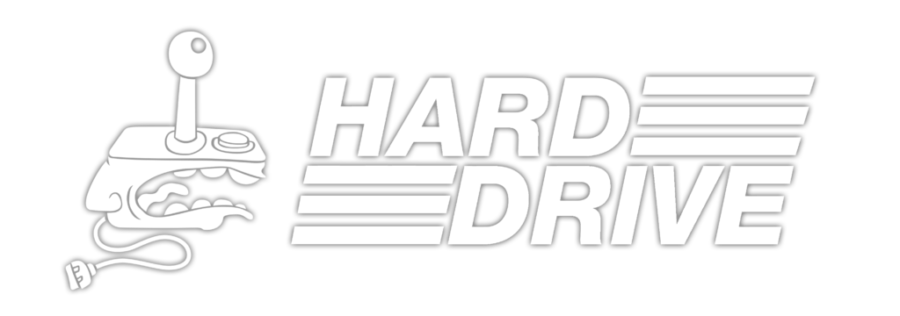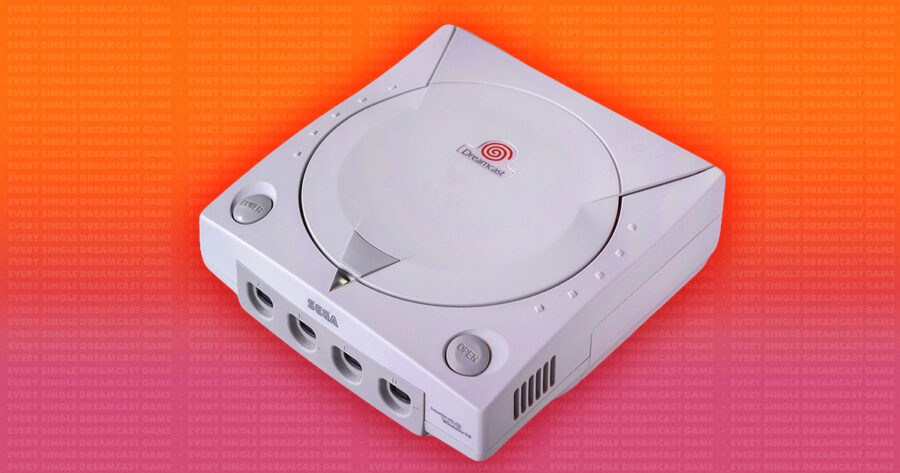#109. Shadow Man
December 1, 1999
Acclaim Studios Teesside
Acclaim Entertainment
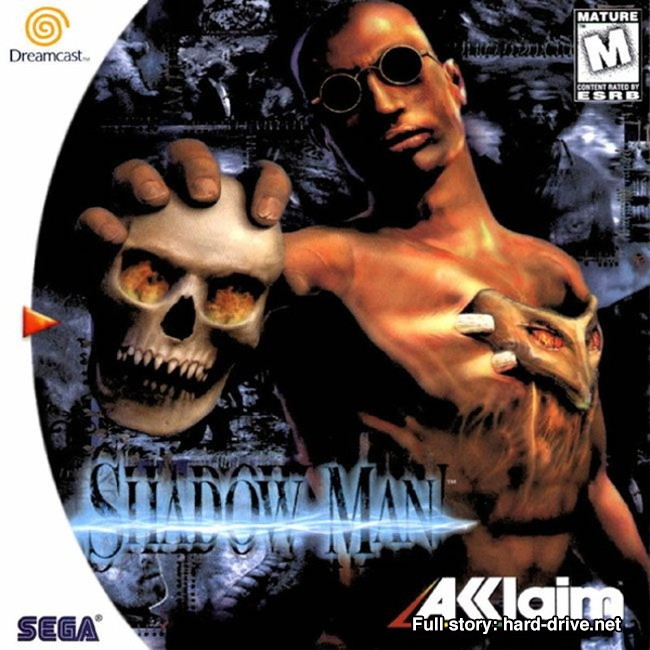 This game is so badass. It’s Tomb Raider meets Ocarina of Time meets Metroid meets Blade. You are Michael LeRoi/Shadow Man, tasked with stopping the apocalypse despite being too old for this shit. You travel back-and-forth between the world of the living (Liveside) and the world of the dead (I’ll let you guess what this world is called; let me remind you again that the living world is called “Liveside”). You advance by recovering Dark Souls—and to boost engagement on this list I’ll go ahead and say this is the best game ever made that requires you to do something like that. Shadow Man boasts an intricate story, excellent voice acting, non-linear gameplay, a chilling atmosphere, and combat that isn’t great but it doesn’t matter because your Shadow Gun has unlimited death-juice-ammo.
This game is so badass. It’s Tomb Raider meets Ocarina of Time meets Metroid meets Blade. You are Michael LeRoi/Shadow Man, tasked with stopping the apocalypse despite being too old for this shit. You travel back-and-forth between the world of the living (Liveside) and the world of the dead (I’ll let you guess what this world is called; let me remind you again that the living world is called “Liveside”). You advance by recovering Dark Souls—and to boost engagement on this list I’ll go ahead and say this is the best game ever made that requires you to do something like that. Shadow Man boasts an intricate story, excellent voice acting, non-linear gameplay, a chilling atmosphere, and combat that isn’t great but it doesn’t matter because your Shadow Gun has unlimited death-juice-ammo.
Now, does a huge chunk of the game’s playtime come from the fact that it’s usually unclear at any given moment what the hell you’re supposed to be doing and where the hell you’re supposed to be going? Perhaps. But no game, no matter how opaque, is any match for the old ‘just keep walking right until you’ve circled the full perimeter of the map’ strategy. — C. Dean
#108. Expendable
September 9, 1999
Rage Software
Infogrames North America
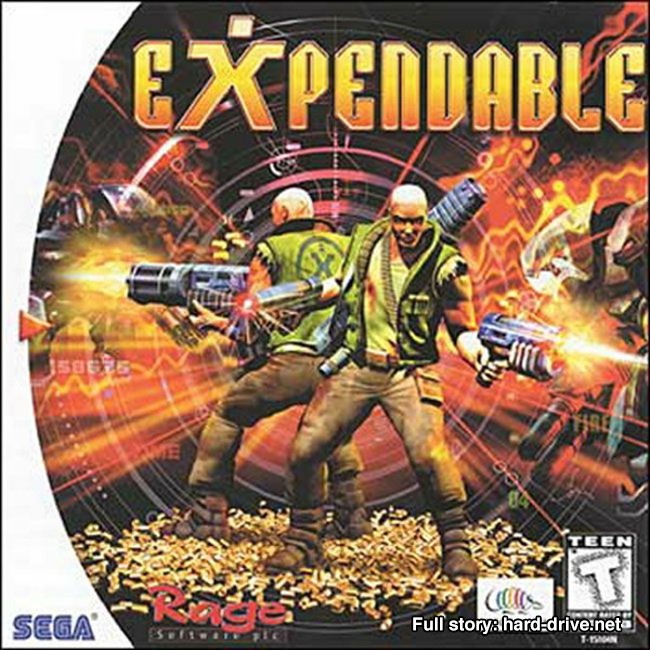 This shouldn’t surprise you, but not all of these games are reviewed on actual Dreamcast systems. A lot of them, out of necessity, need to be emulated. As such, these games do not come with instruction books, back when in-game tutorials were minimal and everything you needed to learn about it was in the accompanying manual. So when a reviewer like myself boots up Expendable, I am immediately thrown into a confusing quagmire of bullets and apocalyptic robots.
This shouldn’t surprise you, but not all of these games are reviewed on actual Dreamcast systems. A lot of them, out of necessity, need to be emulated. As such, these games do not come with instruction books, back when in-game tutorials were minimal and everything you needed to learn about it was in the accompanying manual. So when a reviewer like myself boots up Expendable, I am immediately thrown into a confusing quagmire of bullets and apocalyptic robots.
Expendable (called Millenium Soldier outside the U.S.) is a fun arcade shooter, akin to a 3D Contra, with you controlling an expendable newly-created human soldier in a war against aliens that destroyed humanity. You shoot things, find bigger things to shoot with, shoot at bigger things with your bigger things, and rack up points while things explode. But if you play this, have a PDF of the manual handy so you can understand what’s going on with inventory management and why Mercy Killing is bad. Otherwise Expendable becomes a FromSoft-like inscrutable game that while fun is as confusing as it is enjoyable. Also, I’m docking points for the obnoxious text-scrolling sound that starts and ends each level. — J. Ruggiero
#107. Chicken Run
November 13, 2000
Blitz Games
Eidos Interactive
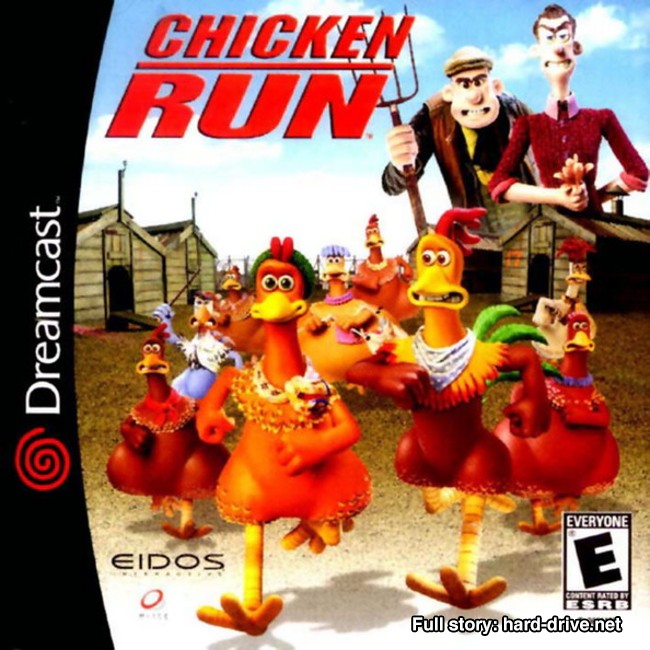 If you enjoyed Metal Gear Solid, but were disappointed by its lack in the anthropomorphic chicken department, then Chicken Run is right up your alley. This stealth-based 3D platformer faithfully follows the same riveting storyline of its namesake claymation movie. In fact, it’s so absolutely faithful that the bulk of the game is just cutscenes ripped straight from the movie. The actual gameplay consists of you, a talking chicken, stealthily trying to escape a farm, avoiding getting caught by the guard dogs, and wondering why no matter what, those fucking dogs always know exactly where you’re at. The animation style was funny at first, but I became scared of it as I played more – it’s a jagged, polygonal version of the movie’s claymation style. It’s a caricature of a caricature, and it borders on the realm of horror. Despite this, something inexplicable compelled me to keep playing. Perhaps it was the relatable motivation of the protagonist, Ginger. I too, would rather not be turned into a chicken pie. — C. Snow
If you enjoyed Metal Gear Solid, but were disappointed by its lack in the anthropomorphic chicken department, then Chicken Run is right up your alley. This stealth-based 3D platformer faithfully follows the same riveting storyline of its namesake claymation movie. In fact, it’s so absolutely faithful that the bulk of the game is just cutscenes ripped straight from the movie. The actual gameplay consists of you, a talking chicken, stealthily trying to escape a farm, avoiding getting caught by the guard dogs, and wondering why no matter what, those fucking dogs always know exactly where you’re at. The animation style was funny at first, but I became scared of it as I played more – it’s a jagged, polygonal version of the movie’s claymation style. It’s a caricature of a caricature, and it borders on the realm of horror. Despite this, something inexplicable compelled me to keep playing. Perhaps it was the relatable motivation of the protagonist, Ginger. I too, would rather not be turned into a chicken pie. — C. Snow
#106. Alien Front Online
August 7, 2001
WOW Entertainment
Sega
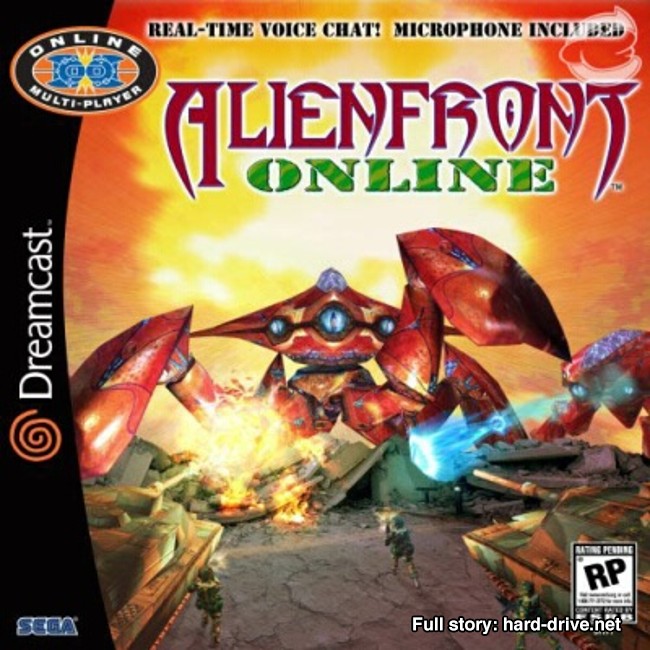
Stop, WOW Entertainment! I can only get so erect before it becomes painful. Alien Front Online does three things and three things only: tanks, alien bugs, and trash-talking over voice comms. It delivers pure carnal entertainment on a level I didn’t think possible, a high that I haven’t experienced since the cinematic masterpiece that is Starship Troopers. Sure it lacks the excitement that are co-ed shower scenes and a psychic Neil Patric Harris spouting his iconic line “It’s afraid,” but Alien Front Online gives me and the boys a platform to talk about manly things while blowing aliens to kingdom come.
Players can enjoy an overly enthusiastic campaign filled with missions from both standpoints. Experience the thrill of tank combat as enemies kill you by sneezing in your direction and fail your way upwards as victory isn’t required for progressing to the next stage. Or you can ignore all of that and get into the chaos that is Arcade mode where respawns are liberal and enemies plentiful. Like a steamy shower on a bug-infested planet, Alien Front Online is best with friends but will get the job done by yourself. — C. Dawson
#105. Airforce Delta
September 7, 1999
Konami Computer Entertainment Yokohama
Konami
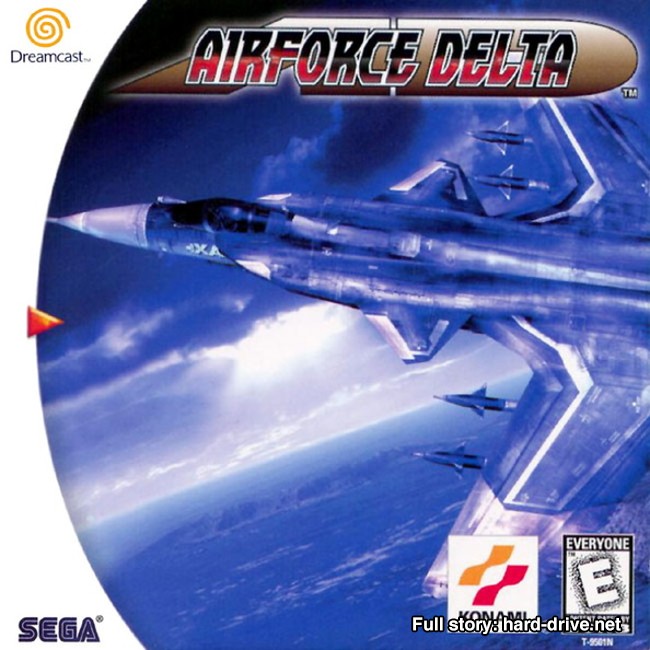
Air combat fans on the Dreamcast had a rough go of it. That is, they did until the release of Airforce Delta. This flight sim puts players in the middle of a conflict in the country I can’t be bothered to remember. Much like a Gundam series, Airforce Delta is all about the action.
With nearly two dozen missions with a decent variety of objectives, Airforce Delta is lean and mean. The plane graphics are as good as the controls are floaty, which is very. It’s a shame that enemy pilots love hiding up your ass as it not only makes them hard to hit but there’s not much to look at besides blocky cityscapes and the open expanse of sky.
Being a member of a mercenary unit, players are expected to purchase their own aircraft. There are nearly three dozen with plenty of real-life counterparts, so there’s something for everyone. Being a simple man, I opted for the coolest-looking ones. One thing to note is that should your ride be destroyed in a mission, you’ll have to buy another before taking to the skies again.
Overall, it was a fairly pleasant surprise. It doesn’t lean too heavily into the realism and the arcade-like gameplay is grounded enough as to not be absurd. It found the line and walked it beautifully. — C. Dawson
#104. Midway Greatest Arcade Hits Volume 2
November 15, 2001
Digital Eclipse
Midway
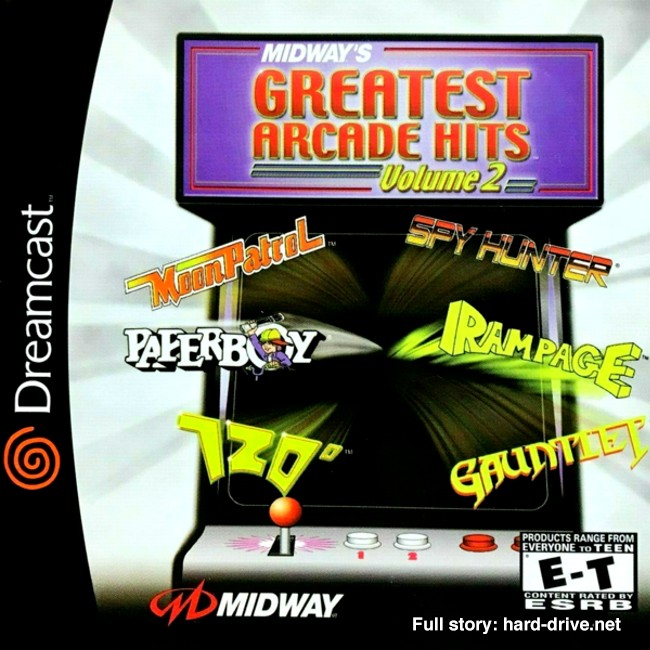
We’re back with another game for the Luddite in the library! This one should look a bit familiar, since we already told you about Midway’s first volume of arcade hits. Again, the games in this one are faithfully translated, and while the user interface is nothing to write home about, it’s functional. The collection of games here is simply better than the first title, so if you have to pick just one, this is the keeper. Rampage, Gauntlet, and Spy Hunter are practically worth the price of entry on their own. The rest of the games feel a bit more dated — especially with their cabinet controls being mapped onto a gamepad — but that shouldn’t phase you, what with your antique sensibilities. Plus, you spend all day in the library, so I know you’ve got time on your hands. — K. Duggan
#103. Worms World Party
May 30, 2001
Team17
Titus Interactive
 Reviews of Worms World Party seem to generally put it lower than its predecessor, Worms Armageddon, but lacking the gift of context or the friends who will play literally any video game online with my cackling, “blasting Badlands Chugs bass-boosted burps down a 10 year-old headset because I think it’s funny” ass, much less a relatively obscure one from 2001 — I think this one’s better! Maybe I’m biased because the single-player offerings (which were all I had meaningful access to) were far more substantial than Armageddon. On top of Missions and freeplay against CPUs, there’s “Scenarios”, fun little (usually) traversal-based challenges on a timer. They’re meagre, but harmless! The game’s tutorials are similarly unintuitive and clunky, but not necessary to take on the game’s Missions — so those of us who don’t know how the fuck to use the fucking Ninja Rope and don’t want to can finally get in on the fun!
Reviews of Worms World Party seem to generally put it lower than its predecessor, Worms Armageddon, but lacking the gift of context or the friends who will play literally any video game online with my cackling, “blasting Badlands Chugs bass-boosted burps down a 10 year-old headset because I think it’s funny” ass, much less a relatively obscure one from 2001 — I think this one’s better! Maybe I’m biased because the single-player offerings (which were all I had meaningful access to) were far more substantial than Armageddon. On top of Missions and freeplay against CPUs, there’s “Scenarios”, fun little (usually) traversal-based challenges on a timer. They’re meagre, but harmless! The game’s tutorials are similarly unintuitive and clunky, but not necessary to take on the game’s Missions — so those of us who don’t know how the fuck to use the fucking Ninja Rope and don’t want to can finally get in on the fun!
Well — I say “fun”, Worms has the tonal dissonance of one of those Spongebob episodes about Sandy looking for a lost snail that features actual footage of the bombs dropping on Hiroshima and Nagasaki. This one in particular has a super vibrant loading screen that invokes Bob Ross painting a Katamari level on MSPaint and then every actual in-game level has skulls on pikes sticking out of hellish rivers of fire set to what might as well be the Ravenholm theme from Half-Life 2. The first mission sees you trying to collect top secret data in a mid-apocalyptic hellscape of global warming and toxic air whilst the sea level rises every turn. Who are you for, Worms? Kids? Adults? Sickos? You’re certainly not for anyone 20 years in the future, that’s for sure! I see your attempts, but the vibes are off. It’s just a bit dour nowadays. — B. Waters
#102. Super Runabout: San Francisco Edition
October 24, 2000
Climax Entertainment
Interplay Entertainment

Do you ever play Grand Theft Auto and wish you could skip all the stupid gun stuff and just focus on the driving missions? Have I got the game for you! Super Runabout: San Francisco is basically Crazy Taxi with a slightly different brand of crazy. Two poorly translated story modes have you driving your way through wacky missions like collecting the ingredients to make a hot dog or destroying phony ambulances by ramming into them. There’s lots of bugs, the controls aren’t perfect, and the draw distance is straight up Magoo levels of bad, but there’s a lot of fun to be had here. The game is genuinely funny, even if it’s always not clear how intentional that humor is, and the large number of unlockable vehicles will keep you busy for a decent chunk of time. Plus, you get extra points for crashing into stuff. Take that, David Harbour in the Gran Turismo movie trailer. — K. Duggan
#101. Alone In The Dark: The New Nightmare
September 26, 2001
Darkworks
Infogrames

Alone in the Dark: The New Nightmare is the fourth title in the series and served as a reboot of sorts for the cult favorite franchise. Players take control of one of two characters, Edward Carnby or Aline Cedrac. Dependent on the character picked, the gameplay is significantly different with Edward’s being more action-oriented and Aline’s focused on solving puzzles. While it was roasted at the time of its release for not reinventing the survival horror wheel, The New Nightmare embodies what made those titles great. The voice acting and plot are laughably bad, tank controls are a go, and there’s a dread that creeps in as players work to uncover the sinister secrets at work. — C. Dawson
#100. Daytona USA
March 12, 2001
Amusement Vision
Sega Hasbro Interactive
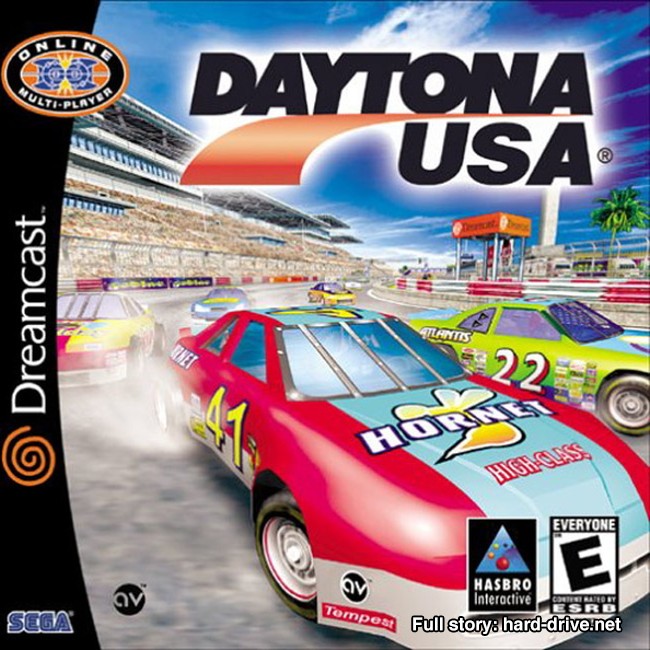 A revamped port of the arcade’s Daytona 2001, they decided to just give this the exact same name as the Saturn game that was based on an older version. So that’s weird! Maybe they were curbing their bets, and thought when people were trying to decide which of the three dozen racing games the Dreamcast offered they’d incept themselves into buying Daytona, because they had so much fun with it on the Saturn? I don’t know what I think, man. Anyway, this is a pretty fun port of an arcade racer. The Championship mode and internet play give it a little more longevity than most of these checkpoint-based arcade racing ports. Also the levels are fantastic. Giant ass slot machines and visages of Sonic carved into stone populate the world of Daytona. Is it really like that down there? I don’t know. I think? Anyway it looks really great.
A revamped port of the arcade’s Daytona 2001, they decided to just give this the exact same name as the Saturn game that was based on an older version. So that’s weird! Maybe they were curbing their bets, and thought when people were trying to decide which of the three dozen racing games the Dreamcast offered they’d incept themselves into buying Daytona, because they had so much fun with it on the Saturn? I don’t know what I think, man. Anyway, this is a pretty fun port of an arcade racer. The Championship mode and internet play give it a little more longevity than most of these checkpoint-based arcade racing ports. Also the levels are fantastic. Giant ass slot machines and visages of Sonic carved into stone populate the world of Daytona. Is it really like that down there? I don’t know. I think? Anyway it looks really great.
One thing I’m not sure I understand is the need for pit row in an arcade racer? My ride is quite evidently fucked up from my reckless style of driving after a few laps, so I pull into the pit stop they provided for me. I get some badly needed new tires, some quick repairs, and am now back in the mix, my car good as new. I’m also trailing all other cars by 45 seconds with three laps left in a eight lap race. It feels like I got Wile E. Coyote’d into a needless pit stop. What gives? — M. Roebuck
#99. Red Dog: Superior Firepower
October 31, 2000
Argonaut Games
Crave Entertainment
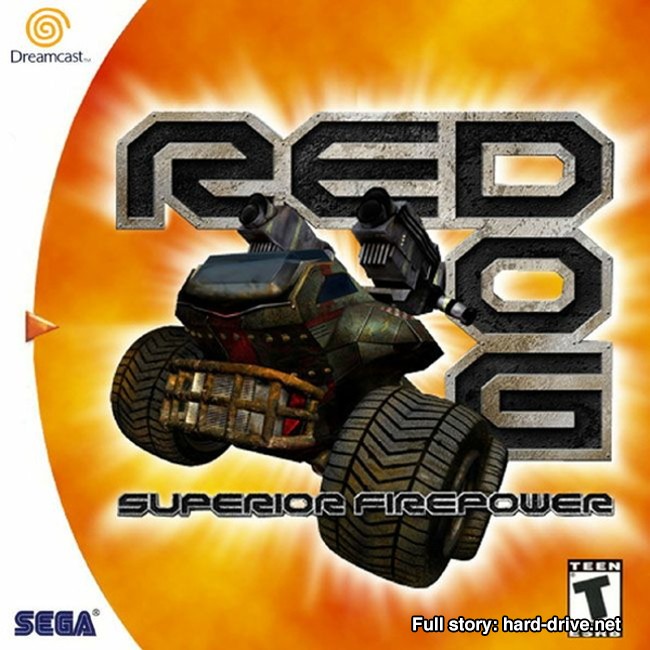 Advertising is important in gaming, especially in the Dreamcast age when all you had to go on was the front and back of a game’s case. When picking up Red Dog: Superior Firepower, your first introduction is the cover, which shows off a cool double-barrel-wielding tank covered in grime and rust; a real bad-ass looking machine. Upon turning it on and jumping into your first mission, though, you’re given control of a tank that looks like it was drawn by a five-year-old with too many crayons. There’s a red-and-white checkered missile launcher, under what look like tennis balls hanging from a blue coat hanger, all on top of a knock-off Halo Warthog. The toy-like look of the Red Dog is strange to look at in contrast with the cool-looking adversarial alien race The Haak. Both you’ll be looking at extensively while you strafe around environments blasting away bad guys with your fanciful war machine. Tank combat has come a long way since Red Dog was released, but it still offers a fun experience, especially if you can wrangle a multiplayer match. The extra options available make it a surprisingly fun party game. — J. Ruggiero
Advertising is important in gaming, especially in the Dreamcast age when all you had to go on was the front and back of a game’s case. When picking up Red Dog: Superior Firepower, your first introduction is the cover, which shows off a cool double-barrel-wielding tank covered in grime and rust; a real bad-ass looking machine. Upon turning it on and jumping into your first mission, though, you’re given control of a tank that looks like it was drawn by a five-year-old with too many crayons. There’s a red-and-white checkered missile launcher, under what look like tennis balls hanging from a blue coat hanger, all on top of a knock-off Halo Warthog. The toy-like look of the Red Dog is strange to look at in contrast with the cool-looking adversarial alien race The Haak. Both you’ll be looking at extensively while you strafe around environments blasting away bad guys with your fanciful war machine. Tank combat has come a long way since Red Dog was released, but it still offers a fun experience, especially if you can wrangle a multiplayer match. The extra options available make it a surprisingly fun party game. — J. Ruggiero
#98. Super Magnetic Neo
June 15, 2000
Genki
Crave Entertainment
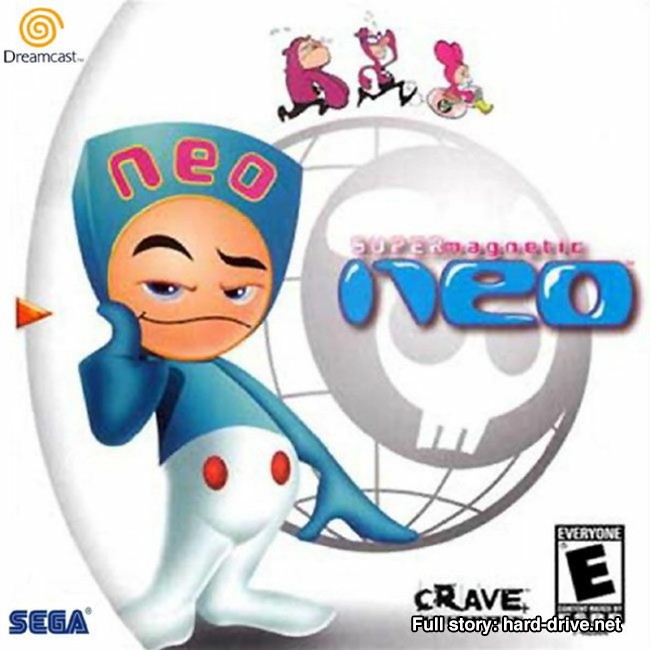 This might be one of the best platformers where your main antagonist is a baby. Super Magnetic Neo is the Dreamcast’s weird attempt to get in on Crash Bandicoot-like platforming fun, with a twist crazy enough to confuse the smartest of juggalos: magnetic powers. Titular Neo can repel and attract various enemies and obstacles depending on their polarity. Attracting and repelling things is a good gimmick, but with little room for error in jumping and attacking Super Magnetic Neo can get frustrating at times. Oh, and did I mention the baby bad guy? Pinki is a pacifier-chomping toddler who’s taken over an amusement park with her Pinki gang and no-good henchmen Gasu and Yasu. If you don’t find defeating the whims of a child amusing, at least you can admire the fact that you get to fight a ballerina robot using only magnets. — J. Ruggiero
This might be one of the best platformers where your main antagonist is a baby. Super Magnetic Neo is the Dreamcast’s weird attempt to get in on Crash Bandicoot-like platforming fun, with a twist crazy enough to confuse the smartest of juggalos: magnetic powers. Titular Neo can repel and attract various enemies and obstacles depending on their polarity. Attracting and repelling things is a good gimmick, but with little room for error in jumping and attacking Super Magnetic Neo can get frustrating at times. Oh, and did I mention the baby bad guy? Pinki is a pacifier-chomping toddler who’s taken over an amusement park with her Pinki gang and no-good henchmen Gasu and Yasu. If you don’t find defeating the whims of a child amusing, at least you can admire the fact that you get to fight a ballerina robot using only magnets. — J. Ruggiero
#97. Maken X
April 25, 2000
Atlus
Sega
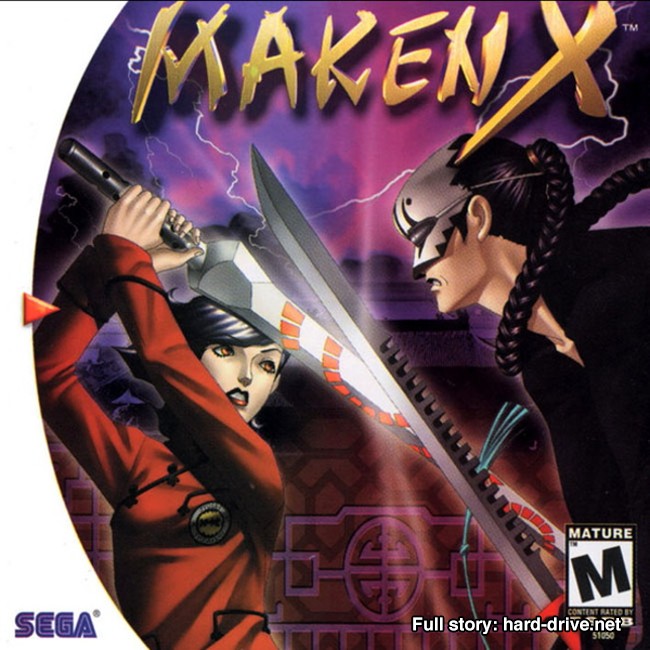 This is a textbook example of a game that came out a couple of years too early. If you’re interested in the history of video games at all, Maken X is an artifact of a period of time before every console came with dual analog sticks, and how developers of certain kinds of games tried to square that circle. Maken X is a first-person hack-and-slasher that tries to put both movement and camera control on the Dreamcast’s single analog stick, and while it works better than I expected, that doesn’t mean it works well.
This is a textbook example of a game that came out a couple of years too early. If you’re interested in the history of video games at all, Maken X is an artifact of a period of time before every console came with dual analog sticks, and how developers of certain kinds of games tried to square that circle. Maken X is a first-person hack-and-slasher that tries to put both movement and camera control on the Dreamcast’s single analog stick, and while it works better than I expected, that doesn’t mean it works well.
Despite how it looks, Maken X has nothing to do with the Shin Megami Tensei series; it was just made by a lot of the same people, including longtime SMT artist Kazuma Kaneko. The only thing it has in common with SMT is an absolutely bugfuck storyline: you play as a sentient sword, who teams up with a Japanese schoolgirl to fight a conspiracy and save her father from ninja ghosts. I am simplifying this dramatically. There’s a cool gimmick where you can “brainjack” people as you move across the world, so you routinely swap weapons and passive abilities as you go. You also get several plot choices which have a dramatic impact on the story, with multiple possible endings both good and bad, as well as the ability to side with the villains. It’s sort of like a supernatural, super anime Deus Ex.
Unfortunately, the controls never get any less awkward with practice, and it also makes a lot of the same mistakes of other contemporary games like stupid first-person platforming sequences. Maken X has its moments, but it’s hard to really recommend as anything other than a historical curiosity. I’d play the hell out of a remake, though, or even a modded version with free-look. — T. Wilde
#96. Sonic Shuffle
November 14, 2000
Hudson Soft
Sega
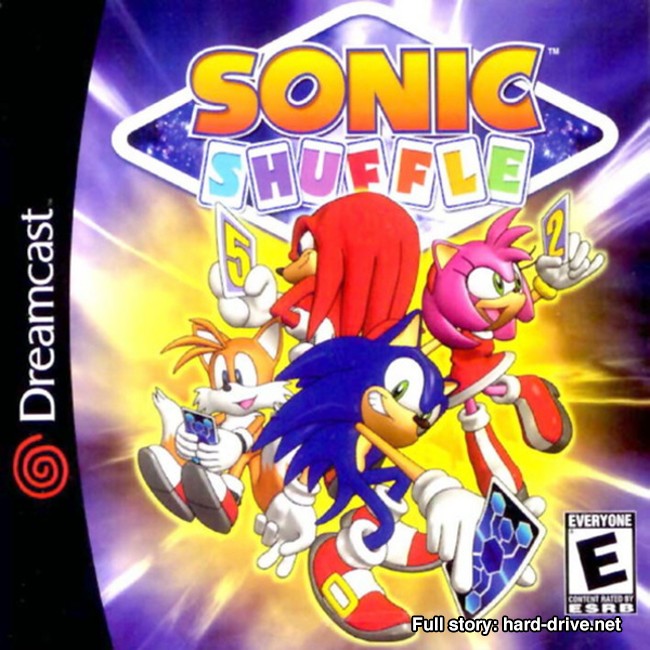
Within the first eight turns of my Sonic Shuffle romp, Knuckles let a baby dolphin die. On an event space in the Emerald Coast board, the game asked him to pick up a beached dolphin calf and return it to the ocean within eight turns. This was somehow too hard for the computer on Normal difficulty to accomplish. As a result, I was treated to a sad little animation of the dolphin’s soul leaving the physical realm. So naturally, we were off to a great start.
It would not be surprising to find out that Hudson, makers of both the Mario Party series and Sonic Shuffle, took bribe money from Nintendo to sabotage SEGA’s entry into the party game milieu. That is the only explanation I can think of for why Sonic Shuffle is as miserable as it is, despite its richly colorful aesthetic, inventive set pieces, and fully-voiced Story Mode. The game’s core weakness? It’s too damn complicated for its own good. Yeah, let me just go ahead and grab a HI-SPEEDERALD from the Shop and make sure the Carbuncle doesn’t gobble it up while I perform a Battle against a fish on ice skates to secure the Precious Stone- ah, shoot, I lost! If only I had stopped by the Forest Gnomes’ workshop before that ACCIDENT!!! event occurred and waited for them to make me another Force Gem!
… you get the idea. And yet, these frills are exactly what makes the game so unique. The colorfully-lit Forest Gnomes hacking away at a tree stump are featured in one of the game’s many delightful random events. My personal favorite scene is the one where you get robbed of 20 Rings by a man who is definitely not Dr. Eggman wearing a priest getup. I’ll give a nod to the freaky stone guardian, too (who curiously looks a bit like the Egg Golem from Sonic Adventure 2, which at the time was no more than a twinkle in Yuji Naka’s insider-trading eye). The designs of newcomer characters Lumina and Void are charming, and the premise of their homeland existing as a dreamscape in humanity’s collective unconscious allows for saturated, dream-like board environments with concepts likely derived from Sonic’s memories, such as an orca smashing through parts of the Emerald Coast boardwalk as you play. It also doubles as a nice homage to the NiGHTS series.
The coolest thing Sonic Shuffle has that Mario Party doesn’t is a “final boss” sequence at the end of each board. In Emerald Coast, for example, everyone has to surf across a tidal wave to escape certain doom. On the Riot Train board, you’ll have to stop the massive train you’ve been riding the whole time from driving itself off the tracks. It’s a fun, last-minute way to score extra Rings while also being an energized, collaborative final push to get everybody across the finish line. Take that, Mario! — L. Fisher
#95. Resident Evil: Code Veronica
March 28, 2000
Capcom Production Studio 4
Capcom
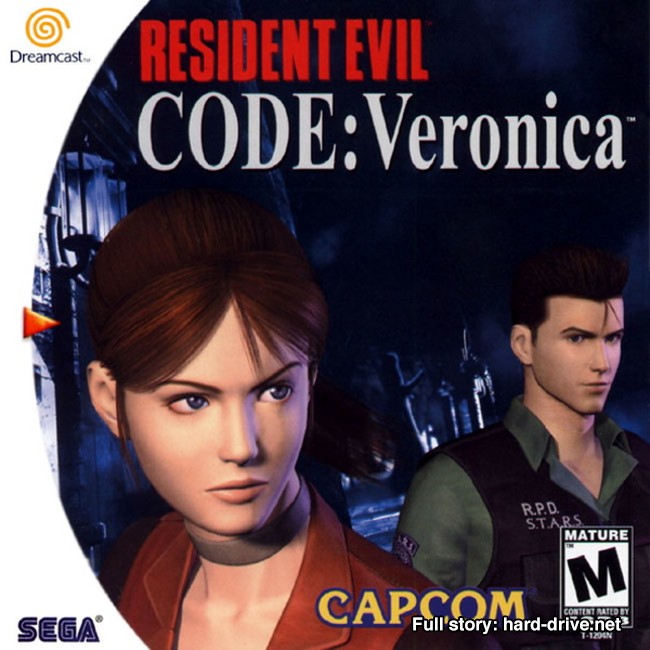 Code Veronica would be the red-headed stepchild of Resident Evil, except the franchise collects red-headed stepchildren like Bruce Wayne collects orphans. The real reason to check out CV at this point is that it’s the craziest plot arc in Resident Evil’s “classic” era. It starts with a John Woo gunfight that sees Claire Redfield mowing down two dozen guys, then moves to a zombie prison with a cross-dressing warden, before spending its last hours on a fight against an ant-themed supervillain. There’s enough story in CV for three or four games and they’re all goddamned ridiculous.
Code Veronica would be the red-headed stepchild of Resident Evil, except the franchise collects red-headed stepchildren like Bruce Wayne collects orphans. The real reason to check out CV at this point is that it’s the craziest plot arc in Resident Evil’s “classic” era. It starts with a John Woo gunfight that sees Claire Redfield mowing down two dozen guys, then moves to a zombie prison with a cross-dressing warden, before spending its last hours on a fight against an ant-themed supervillain. There’s enough story in CV for three or four games and they’re all goddamned ridiculous.
Even better, CV introduces the infamous Steve Burnside, Claire’s bumbling sidekick, and the precise opposite of every audience-surrogate cool guy in fiction. He’s caught in the middle of a genuine zombie apocalypse, so he grabs dual machine guns and goes to do dumb shit in order to impress the first girl he sees. Instead of being the big hero, though, his fuck-ups consistently make his and Claire’s situation worse. Steve’s biggest win still involves him getting shot. It’s almost a character deconstruction, and like a lot of things in Resident Evil, it’s hard to tell if Steve was written that way on purpose. I’d like to believe so.
Mechanically, CV is in a strange liminal zone. It looks great if you’re coming over from the PlayStation or N64, but it got quickly outclassed by PS2 and Xbox games. If you compare CV to Silent Hill 2, you’d never believe they only came out a year apart. That same sense carries forward to CV’s position in its franchise. RE3 introduced a number of new mechanics that should’ve been in CV, like the Active Choice system or the dodge move. CV, by comparison, is “just” a next-generation RE2 with worse puzzles. It looks better but has aged worse than its predecessors. — T. Wilde
#94. Tom Clancy’s Rainbow Six
May 9, 2000
Red Storm Entertainment
Majesco Sales
 Behold! The only reason your stepfather, who wrote-in voted for Ronald Reagan even after he was dead, decided to pick up a video game controller. Tom Clancy’s Rainbow Six could have just as easily been called “conservative m*sturbation fantasy scenarios,” but Tom Clancy had mortgage payments and conservatives think masturbation is best never spoken about in public so Rainbow Six was a fair compromise.
Behold! The only reason your stepfather, who wrote-in voted for Ronald Reagan even after he was dead, decided to pick up a video game controller. Tom Clancy’s Rainbow Six could have just as easily been called “conservative m*sturbation fantasy scenarios,” but Tom Clancy had mortgage payments and conservatives think masturbation is best never spoken about in public so Rainbow Six was a fair compromise.
The game does do a pretty good job of embodying that pre-9/11 cockiness that the first world had towards international terrorism, and I was totally going to compliment it on another thing right here but talking about complex game mechanics following a statement about terrorism does not feel good to me. Still, Tom Clancy’s Rainbow Six is better than okay. And for a game that bears the namesake of a man who, if he was alive today, would definitely have his own type of cryptocurrency, that’s some pretty high praise. — J. Knapp
#93. Gauntlet Legends
June 6, 2000
Midway Games West
Midway Home Entertainment

There was a time when you would see Gauntlet Legends literally everywhere. This title hopped platforms like herpes at a swinger’s party. Its popularity began in arcades and spread to the Nintendo 64, PlayStation, and Dreamcast. Gauntlet Legends is the epitome of the party game. It is best enjoyed with friends as up to four players could cause nigh unlimited chaos on-screen. Sure, the graphics aren’t the greatest, the levels are simple, and the booming announcer’s voice sounds like it was recorded over a loudspeaker, but that ultimately adds to the charm of the brawler.
The solo play isn’t nearly as fun, but it still holds up if you’re looking for a few hours of mindless, nostalgic entertainment. There’s plenty of content packed into Legends in terms of the sheer number of levels available. There’s a pretty barebone leveling system in place, but it’s just enough to keep you invested in your chosen character. Overall, it’s one of those games that pulls its weight. It’s not great and it’s far from terrible. Instead, it’s the catalyst for forming some great memories with friends as you boot it up for a wild Friday night. — C. Dawson
#92. Star Wars: Episode I Racer
April 4, 2000
LucasArts
 I’ve spent most of my life hating the Star Wars prequel trilogy, so I can only react with disgust as I start to see a critical reassessment slowly taking hold. But even if I still think the movies were deplorably bad, I concede that two good things did come of the whole exercise: the badass poster where Jake Lloyd’s shadow is Darth Vader and Star Wars Episode 1: Racer. A game with a real sense of speed, Racer features longer levels, more strategy, and deeper customization than most other entries in the genre from this time. The only thing that always really irked me is that only Sebulba’s pod has the ability to attack. You’re telling me you couldn’t have other pods deploy Eopie farts towards their competitors? Meesa pissed. — John Danek
I’ve spent most of my life hating the Star Wars prequel trilogy, so I can only react with disgust as I start to see a critical reassessment slowly taking hold. But even if I still think the movies were deplorably bad, I concede that two good things did come of the whole exercise: the badass poster where Jake Lloyd’s shadow is Darth Vader and Star Wars Episode 1: Racer. A game with a real sense of speed, Racer features longer levels, more strategy, and deeper customization than most other entries in the genre from this time. The only thing that always really irked me is that only Sebulba’s pod has the ability to attack. You’re telling me you couldn’t have other pods deploy Eopie farts towards their competitors? Meesa pissed. — John Danek
#91. Tee Off
January 12, 2000
Bottom Up
Acclaim Entertainment
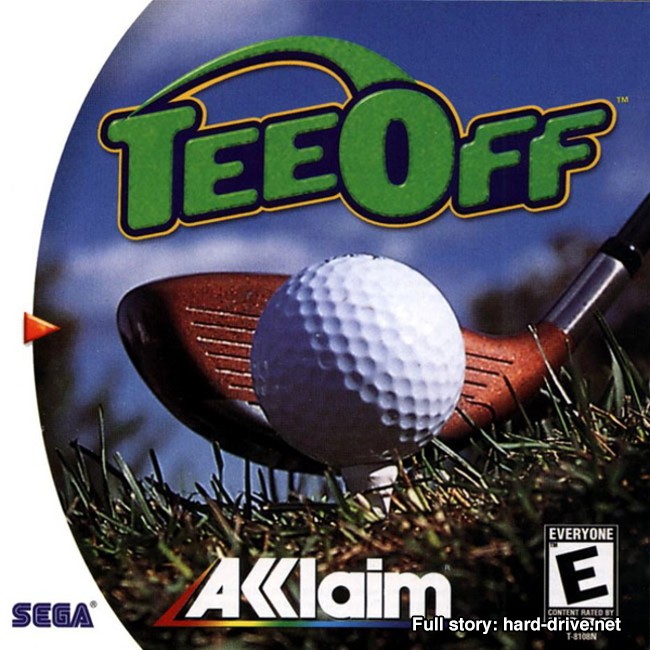 For being the Dreamcast’s lone golf game (on a system with 38 tennis games, no less), Tee Off steps up to the plate and hits a three pointer. This is a fun, Hot Shots Golf! style take on the sport, not a realistic PGA one, unless cowpoke Randy Wilde and his glorious cowboy hat were real, but alas, there’s just no fucking way. Not a lot of surprises here, just a solid arcade style golf game. It’s a little easy, but the adjustable difficulty provides a nice counterpoint to that. — M. Roebuck
For being the Dreamcast’s lone golf game (on a system with 38 tennis games, no less), Tee Off steps up to the plate and hits a three pointer. This is a fun, Hot Shots Golf! style take on the sport, not a realistic PGA one, unless cowpoke Randy Wilde and his glorious cowboy hat were real, but alas, there’s just no fucking way. Not a lot of surprises here, just a solid arcade style golf game. It’s a little easy, but the adjustable difficulty provides a nice counterpoint to that. — M. Roebuck
#90. Ultimate Fighting Championship
August 29, 2000
Anchor Inc.
Crave Entertainment

My horrible perception of time may have shaded my opinion of this game. I saw an Ultimate Fighting Championship game from 23 years ago and assumed I would be gouging eyes and punching groins on my way to winning a belt. Apparently, by the year 2000, the UFC was a more respectable organization where some holds were, indeed, barred. Still, the combat holds up, which is no easy feat for a 3D fighting sim from the turn of the millennium. The learning curve is steep, but it’s a fairly satisfying system once you’ve gotten the hang of it. There’s a decent number of combos, submissions, and counters, though it doesn’t feel as diverse as it might look on paper. Ultimately, though the game is arguably more polished than most of the professional wrestling games from the same era, it is sorely missing the bombastic wackiness that made those titles so much fun to play. I’m just saying, they should have let me get away with nard shots. — K. Duggan
